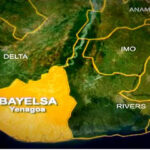The Director-General, Nigeria Hydrological Services Agency (NIHSA), Engr. Clement Eze has said that the highlights of the 2022 Annual Flood Outlook (AFO) show that 233 Local Government Areas in 32 states including the Federal Capital Territory in the country fall within the highly probable flood risk area.
Speaking yesterday in Abuja at the Public Presentation of the Disaster Risk Management Implications of the 2022 flood predictions by the National Emergency Management Agency (NEMA), he mentioned Adamawa, Abia, Akwa-Ibom, Anambra, Bauchi, Bayelsa, Benue, Cross-River, Delta, Ebonyi, Ekiti, Edo as part of the highly probable flood risk areas.
Church suspends priest for joining Benue governorship race
CBN: No plan to withdraw naira notes from circulation
Amongst the highly probable flood risk areas mentioned are Gombe, Imo, Jigawa, Kaduna, Kano, Kebbi, Kogi, Kwara, Lagos, Nasarawa, Niger, Ogun, Ondo, Pain, Oyo, Rivers, Sokoto, Taraba, Gone Zamafara and the FCT.
Eze said 212 LGAs in 35 states of the country including the FCT fell within the moderately probable flood risk areas.
He noted that the remaining 329 LGAs fall within the probable flood risk areas.
The NIHSA stressed that in terms of severity of the flood events, the highly probable flood risk was expected in parts of 57 LGAs in the country in April, May and June while parts of 220 LGAs in July, August and September and 38 LGAs within October and November.
He noted that the flood incidence in the period mentioned would have a significant impact on the population, agriculture, livelihood, livestock, infrastructure and environment.
Eze said that probable flood risk incidences between April and November were expected in 45 LGAs; within April, May and June, hence, in parts of 140 LGAs within the months of July, August and September.
“Rivers, Bayelsa, Cross-River, Delta, Edo, Lagos, Ogun and Ondo are expected to experience coastal flooding due to rise in sea level and tidal surge which would impact on fishing, coastal and wildlife habitation and river navigation.”
“Flash and urban flood will be experienced in urban city centres across the country. Part of these cities are Lagos, Kaduna, Suleja, Gombe, Yola, Makurdi, Abuja, Lafiya, Asana, Port-harcourt, Yenegoa, Ibadan, Abeokuta, Benin City, Birnin-Kebbi, Sokoto, Lokoja, Maiduguri, Kano, Oshogbo, Ado-Ekiti, Abakaliki, Waka, Nsukka, Calabar and Owerri,” he said.
Eze stressed that all planners, decision and policymakers, farmers, stakeholders and the general public should embark on preventive measures to improve safety and reduce the potential damage to lives and properties.
On his part, Director-General, NEMA, Alh. Mustapha Habib Ahmed said it was imperative for individuals and state governments to take responsibility for contributing to disaster management issues within them rather than abandon every responsibility to the federal government.

 Join Daily Trust WhatsApp Community For Quick Access To News and Happenings Around You.
Join Daily Trust WhatsApp Community For Quick Access To News and Happenings Around You.

